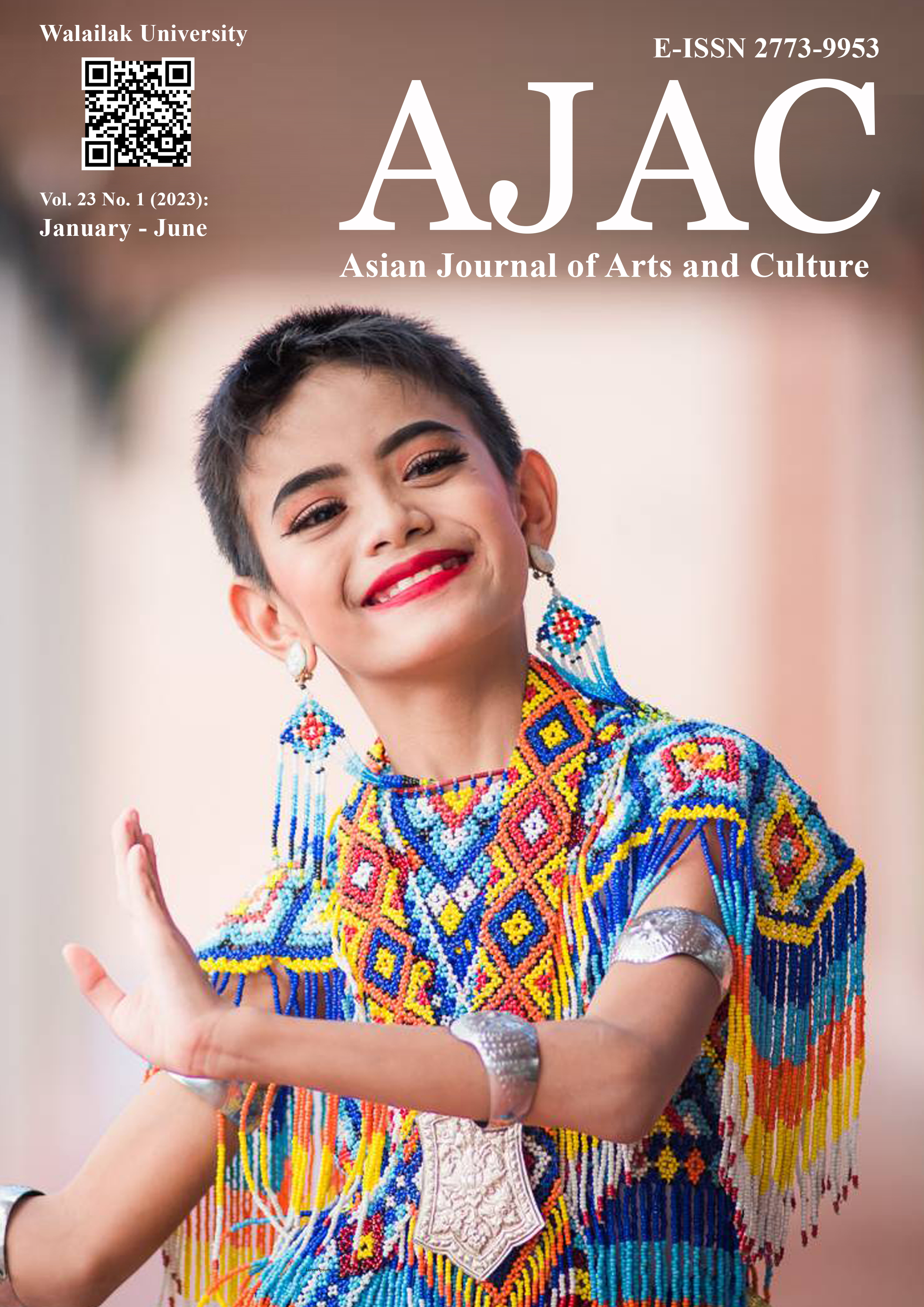Northeastern Thai Local Wisdom as Creativity Sources: A Case of the Collaboration Concept in Weaving Methods Using Tung Strings and Bamboo Strains as Lamp Design
Main Article Content
Abstract
The research on local wisdom in northeastern Thailand as a creativity source is part of the study of the bamboo weaving method's application to new concept design in the scope of cross- culture. Observing cultural community character and applying it to evaluating design between Northeastern cultural characters resulted in the development of a new weaving concept involving tung strings and bamboo strains. In approaching the bamboo weaving scope, the methods for selecting the population were purposeful and quota
sampling, which aimed to emphasize the importance of creativity development, treatment of the material sector, and culture in the product function approach. Managing the community's design thinking step activity in the woven product as a source of creativity helps determine the framework based on conditions to set new goals for product development based on the philosophy of art in shape and methods used by the local community. Weaving is a social activity practiced by people in northeastern Thailand. On occasion, woven products are used as functional items, tung as decorative items, and silk weaving as an identity.
Article Details

This work is licensed under a Creative Commons Attribution-NonCommercial-NoDerivatives 4.0 International License.
© 2018 by Asian Journal of Arts and Culture, Walailak University. All rights reserved.
References
Boonpila, N. (2015). Ways of life, beliefs, and wisdom of Phu-Tai tribes in northeastern Thailand. Mekong Chi Mun Art and Culture Journal, 1(5), 111–132.
Chunhabunyatip, P., Chuaysook, D., & Aromrucks, S. (2020). A community branding development forethnic identity and eco-cultural tourism in Nakhon Phanom province, Thailand. AU-GSB EJOURNAL, 13(1), 28–40.
Chotiwtutideacha, S., Taeporamaysamai, P., & Wongadisai, W. (2019). Tourists’ perception affecting decision-making on visiting Nakhon Phanom. The 2019 International Academic Research Conference in Vienna. (pp. 338–344). Vienna, Austria.
Deng, L., Zhou, F., & Zhang, Z. (2022). Interactive genetic color matching design of cultural and creative products considering color image and visual aesthetics. Heliyon, 8(9), 1–14.
INBAR. (2021). International network for bamboo and rattan, bamboo value chain analysis in Thailand. Retrieved from https://www.inbar.int.
Kleber, D. M.-S. (2018). Design thinking for creating an increased value proposition to improve customer experience. ETIKONOMI, 17(2), 256–274.
Mahasarakham Local Custom. (2020). Local wisdom 8 thai ways community identity Maha Sarakham province by the Maha Sarakham provincial cultural office ministry of culture. Retrieved from https://www.m-culture.go.th/mahasarakham.
Meethaisong, T. (2021). An adaptation of culture and beliefs in Isan society. Sripatum Review ofHumanities and Social Sciences, 21(2), 56–70.
Nambutr, W. (2005). The community-ecotourism route network development on the lower of the Mekong river. (Master’s Thesis, Mahidol University, Thailand)
One Tambon One Product. (2022). One tambon one product summary report. Retrieved from https://otop.cdd.go.th.
Phakdeesuwan, S. (2010). Pattern design for mudmee silk fabrics of Maha Sarakham province in contemporary culture context. Chophayom Journal, 21(2), 17–35.
Prud’homme van Reine, P. (2017). The culture of design thinking for innovation. Journal of Innovation Management, 5(2), 56–80.
Ravasi, D., & Stigliani, I. (2012). Product design: A review and research agenda for management studies. International Journal of Management Reviews, 14(4), 464–488.
Saenwa, S. (2020). Knowledge transfer of local wisdom on wickerwork handicrafts in the northeastern region of Thailand. Journal of Human Sciences, 21(3), 177–199.
Stolarick, K., Denstedt, M., Donald, B., & Spencer, G. M. (2010). Creativity, tourism and economic development in a rural context: The case of Prince Edward County. Journal of Rural and Community Development, 5(1/2), 238–254.
Suwanlee, S. R., & Som-ard, J. (2020). Spatial interaction effect of population density patterns in subdistricts of northeastern Thailand. ISPRS International Journal of Geo-Information, 9(9), 1–15.
Tabuena, A., C. (2022). Creative expression on how do artists communicate their message: An arts in development article critique. Asian Journal of Arts and Culture, 22(2), 257372, 1–5.
Upphapong, B., Champadaeng, S., & Sookna, S. (2013). The development of bamboo basketry according to the base of creative economy of the Thai Yo ethnic group in northeast Thailand. Asian Social Science, 9(10), 231–236.
Yilmaz, Y., & El-Gamil, R. (2018). Cultural heritage management in Turkey and Egypt: A comparative study. Advances in Hospitality and Tourism Research, 6(1), 68–91.


